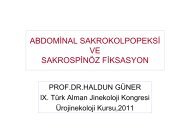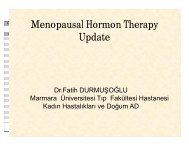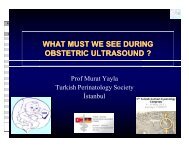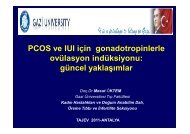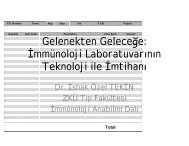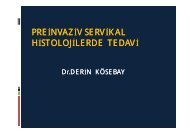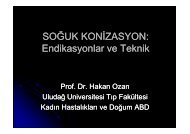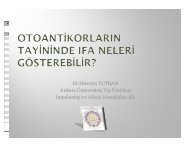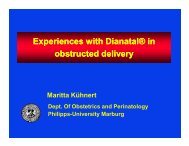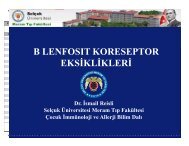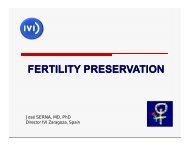Rıfat H. Gürsoy_Elective Single Embryo Transfer (eSET).ppt ...
Rıfat H. Gürsoy_Elective Single Embryo Transfer (eSET).ppt ...
Rıfat H. Gürsoy_Elective Single Embryo Transfer (eSET).ppt ...
Create successful ePaper yourself
Turn your PDF publications into a flip-book with our unique Google optimized e-Paper software.
P.O. Number Terms Rep Ship Via F.O.B. Project<br />
Quantity Item Code Description Price Each Amount<br />
<strong>Elective</strong> <strong>Single</strong> <strong>Embryo</strong><br />
<strong>Transfer</strong> (<strong>eSET</strong>);<br />
How Much Reasonable ?<br />
Rifat H. <strong>Gürsoy</strong> ,M.D.<br />
Gazi University School of Medicine<br />
Dept. Of Ob/Gyn<br />
Reproductive Endocrinology & Infertility<br />
Division<br />
Ankara-TURKEY<br />
Total
Background<br />
•Multiple embryo tranfer during IVF has<br />
increased multiple pregnancy rates (MPR)<br />
causing maternal and perinatal morbidity<br />
•<strong>Elective</strong> single embryo transfer (<strong>eSET</strong>) is<br />
now being considered as an effective<br />
means of reducing this iatrogenic<br />
complications
Background<br />
Women undergoing treatment<br />
with IVF face to an approximately<br />
20-fold increased risk of twins and<br />
400-fold risk of higher order<br />
pregnancies
Background<br />
When compared with single<br />
births, twins have a 4-fold<br />
increased risk of mortality and for<br />
triplets the risk is 6-fold higher.
The Perinatal Mortality Rate in England<br />
(1995)<br />
•General : 8.7 / per 1000<br />
•IVF singletons: 8.8 / per 1000<br />
•IVF twins :46.8 / per 1000<br />
•IVF triplets : 82.6 / per 1000<br />
•All IVF births: 22.6 / per 1000
Multiple Gestations<br />
•Increased incidence of preterm births<br />
•Handicapped infants<br />
–Twins : 1/13<br />
–Triplets : 1/5<br />
•Higher malformation rates with<br />
IVF/ICSI
Obstetric Complications of<br />
Multiple Gestations<br />
•Miscarriage<br />
•Pregnancy Induced Hypertention<br />
•Gestational Diabetes<br />
•Premature Labour<br />
•Abnormal Delivery<br />
•Higher C/S indications
Economic Impact of<br />
Multiple Gestations<br />
•The increased cost associated<br />
with prenatal care twin and higher<br />
order pregnancies<br />
•The cost of the subsequent<br />
neonatal intensive care
Parenthood of Multiple Gestations<br />
•Practical dificulties<br />
•Residuel stress<br />
•Demand of more resources<br />
•Emotional stress
Strategies to Minimise the Multiple<br />
Pregnancies<br />
•Multi-fetal pregnancy reduction<br />
(MFPR)<br />
•Individualised embryo transfer<br />
policy<br />
•Blastocyst transfer<br />
•<strong>Elective</strong> single embryo transfer
<strong>Elective</strong> <strong>Single</strong> <strong>Embryo</strong> <strong>Transfer</strong><br />
(<strong>eSET</strong>)<br />
Untill recently, <strong>eSET</strong> was not an<br />
optional in clinical practice, for<br />
fear tahat the overall success<br />
rates would decline , too far
Reason of This Presumption<br />
•Published data of single embryo transfer<br />
where only one embryo was available<br />
•No opportunity for selection of more<br />
suitable embryos exists<br />
•Poor potential of the only available embryo<br />
(around 10%)
<strong>Single</strong> <strong>Embryo</strong> <strong>Transfer</strong><br />
(Vilska ,1999-Finland)<br />
PR (%)<br />
Only 1 embryo available 20.2<br />
After selection 29.7<br />
<strong>eSET</strong> + 1frozen/ thawed 47.3 (CPR)
DET vs SET , LBR
DET vs SET , CPR
DET vs SET ,MPR
DET vs SET ,Abortion
DET vs SET+FZET , LBR
DET vs SET+FZET ,CPR
DET vs SET+FZET ,MPR
DET vs 2 f-SET, LBR
DET vs 2 f-SET, CPR
DET vs 2 f-SET, MPR
DET vs 2 f-SET, Abortion
DET vs TET , MPR
CONCLUSIONS-I<br />
•In a single fresh IVF cycle, <strong>eSET</strong> is<br />
associated with a lower LBR than DET<br />
•There is no significant difference in CLBR<br />
following SET+1 FZET and the LBR<br />
following a single cycle of DET<br />
•MPR are lowered following SET compared<br />
with other transfer policies
Registry<br />
• European Society of Human Reproduction &<br />
<strong>Embryo</strong>logy (ESHRE)<br />
• Australian & New Zealand Assisted Reproduction<br />
Database (ANZARD)<br />
• The International Committee for Monitoring Assisted<br />
Reproductive Technology (ICMART)<br />
• Canadian ART register<br />
• Society of Assisted Reproductive Technology, USA<br />
(SART)<br />
• Human Fertilization & <strong>Embryo</strong>logy authority (HFEA, UK)
2.8%<br />
69.4%<br />
# 47 348 (20.0%) SET -Avrupa 2005 ; Sweden (69.4%), Finland (49.7%),<br />
Belgium (48.0%), Denmark (32.6%), Slovenia (30.0%), Bulgaria (8.5%),<br />
US 2007 (2.8%), Avustralya (56.9%), Kanada (11%), Latin Amerika (6.5%),<br />
Japonya (54.8%)
CONCLUSIONS-II<br />
•e-SET may be an effective policy<br />
regarding to lower the incidence of high<br />
order pregnancies<br />
•But should not to be considered as the<br />
only and the sole choice



![Engin Oral_Konjenital uterus anomalileri.ppt [Uyumluluk Modu]](https://img.yumpu.com/51729800/1/190x146/engin-oral-konjenital-uterus-anomalilerippt-uyumluluk-modu.jpg?quality=85)
